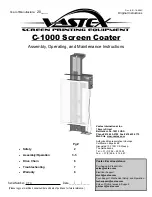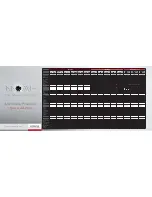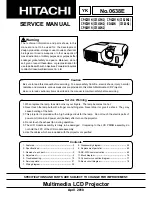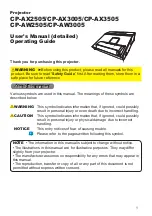
Installation and Setup
Mirage M Series User Manual
46
020-101942-02 Rev. 1 (10-2018)
Video decoder input card
This card accepts and decodes standard definition (SD) video, including CVBS (composite video), S-
Video, and component sources. This card supports as many as six video signals, four of them on
BNC connectors and two on four-pin mini-DIN connectors. Each mini-DIN connector accepts one S-
Video signal. The first BNC accepts composite video (only), while the remaining three BNC’s can be
grouped to allow one of the following combinations:
• three CVBS sources on 4, 5 and 6
• one CVBS source, one S-Video source: Luma (Y) connected to 4(Sy) and Chroma (C)
connected to 6 (Sc)
• one YPbPr source: component signal on 4 (Pr), 5 (Y) and 6 (Pb)
The video decoder input card has eight LED indicators. The PWR LED indicates that the module is
installed properly, and has been successfully configured. The YPbPr LED indicates a valid component
signal has been detected on inputs 4, 5, and 6. Component input grouping must also be selected in
the projector menu
.
The remaining LEDs are each associated with one of the inputs and indicate a
valid signal has been detected on that input.
DMXC interface card
The DMXC card is a communication interface which allows the projector to be controlled using the
standard E1.11 USITT DMX512-A protocol (DMX512-A 2008). DMX-512 is a serial protocol which is
used for controlling lighting and staging equipment from a lighting console or similar host device.
ArtNET (defined by Artistic License's Art-Net II Specification) is an Ethernet implementation of the
DMX protocol. The Mirage M Series projector supports the DMX protocol through two data input
interfaces, a DMX card and ArtNET through the Ethernet connector.
The DMXC card is not an input interface for video signals, but it plugs into a standard input card
option slot. The card can always be active, even when the projector is in standby mode. Only one
DMXC card is allowed per system. If more than one card is installed, only the first card is activated.
The card has two five-pin XLR connectors—one (input) male and one (output) female. Two LEDs are
on the faceplate of the card: the green power LED which is on when the card is powered and the
green termination LED which is on when termination is enabled.
Input termination (2 Watt, 120 Ohm) is required on the last DMXC card in a loop through
configuration (such as only on the last projector). Termination may be either hardware (by plugging
in a termination dongle, for example) or may be switched by software but should not be both.
Software termination is only in place when the projector has AC applied. If there are cases where
the network is required to be terminated without AC applied to the last projector, a hardware
terminator should be used.
http://www.pureglare.com.au
















































